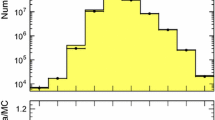Summary
The proposed method is based essentially on the characteristics of thep t/M distribution of shower particles, which shows clearly resolved peaks for the most copiously produced particles—protons and pions. This distribution is obtained (through the relationp t/M=γβ sin θ) by measuring the values of the emission angle θ and estimating γ from a precise measurement of the blob density. Distribution factors, which give the relative number of different types of particles, are computed for each measured shower particle and thus the distributions of various dynamical quantities are obtained. The method has been applied for the analysis of 22.8 GeV/c p-n interactions and the results have been found to be in very good agreement with those obtained by the usual (g *,pβ) method.
Riassunto
Il metodo proposto si basa essenzialmente sulle caratteristiche della distribuzionep t/M delle particelle degli sciami, che mostra chiaramente picchi risolti per le particelle prodotte più copiosamente, protoni e pioni. Si ottiene questa distribuzione (tramite la relazionep t/M=γβ sin θ) misurando i valori dell'angolo di emissione θ e stimando γ da una precisa misura della densità delle bolle. Si calcolano i fattori di distribuzione, che danno i numeri relativi dei differenti tipi di particelle, per ogni particella dello sciame misurata, e così si ottengono le distribuzioni delle varie grandezze dinamiche. Si è applicato questo metodo all'analisi delle interazioni p-n di 22.8 GeV/c e si è trovato che i risultati sono in ottimo accordo con quelli ottenuti con l'usuale metodo (g *,pβ).
Резюме
Предложенный метод, главным образом, основан на характеристикахp t/M распределения частиц ливня, которое обнаруживает явно разделенные пики для наиболее обильно рожденных частиц, протонов и пионов. Это распределение вычисляется (при помощи соотношенияp t/M=γβ sin θ) посредством измерения величины угла излучения θ и оценки γ из точного измерения «капельной» плотности. Коэффициенты распределения, которые дают относительное число различных типов частиц, вычисляются для каждой измеренной частицы ливня. Таким образом, получаются различные динамические величины. Этот метод был использован для анализа p-n взаимодействий с импульсом 22.8 ГэВ/с. Результаты анализа хорошо согласуются с результатами, полученными с помощью обычного (g *,pβ) метода.
Similar content being viewed by others
References
C. F. Powell, P. H. Fowler andD. H. Perkins:The Study of Elementary Particles by the Photographic Method (London, 1959), p. 162.
D. R. O. Morrison: CERN/TC/Physics/63-1.
G. Cocconi, L. J. Koestler andD. H. Perkins: Lawrence Radiation Laboratory Report No. UCID-1444 (1961), unpublished.
J. Orear:Phys. Lett.,13, 190 (1964).
P. L. Jain, H. C. Glahe, J. D. Rinaldo andP. D. Bharadwaj:Nuovo Cimento,32, 873 (1964).
E. M. Friedländer:Nuovo Cimento,41 A, 417 (1966).
B. Bhowmik andR. K. Shivpuri:Phys. Rev.,160, 1227 (1967).
C. A. Nicoletta, P. J. McNulty andP. L. Jain:Phys. Rev.,164, 1693 (1967).
W. H. Barkas:Nuclear Research Emulsion, Vol.1 (New York, 1963), p. 351.
K. Imaeda andJ. Avidan:Nuovo Cimento,32, 1497 (1964).
H. H. Aly, M. F. Kaplon andM. L. Shen:Nuovo Cimento,32, 905 (1964).
K. Pinkau:Phil. Mag.,6, 637 (1961).
J. S. Takibaev, E. G. Boos andN. P. Pavlova:Trudy Inst. Yadern. Fiz. Alma Ata,6, 90 (1963).
Author information
Authors and Affiliations
Additional information
Traduzione a cura della Redazione.
Переведено редакцией.
Rights and permissions
About this article
Cite this article
Bhowmik, B., Singh, S. & Jha, S.K. A new approach for the analysis of shower particles produced in high-energy interactions. Nuov Cim A 3, 250–258 (1971). https://doi.org/10.1007/BF02813687
Received:
Published:
Issue Date:
DOI: https://doi.org/10.1007/BF02813687




